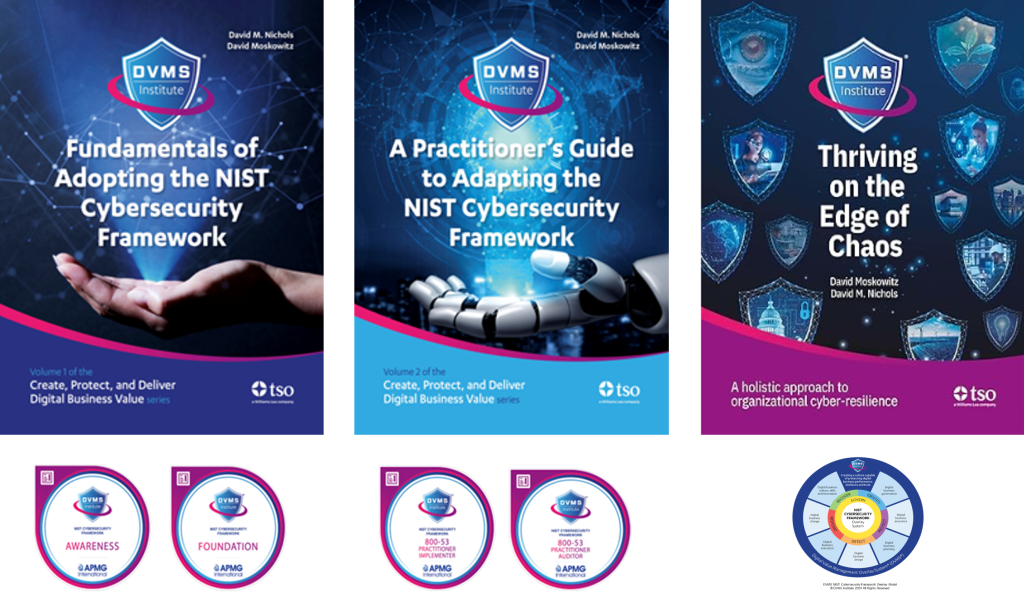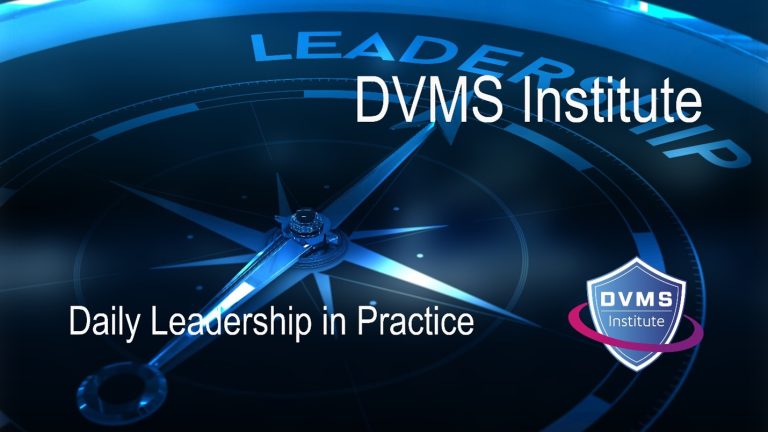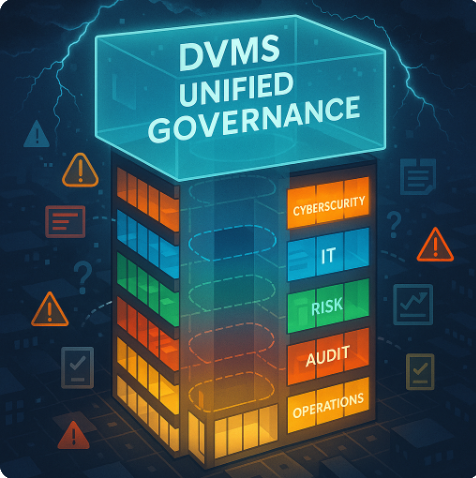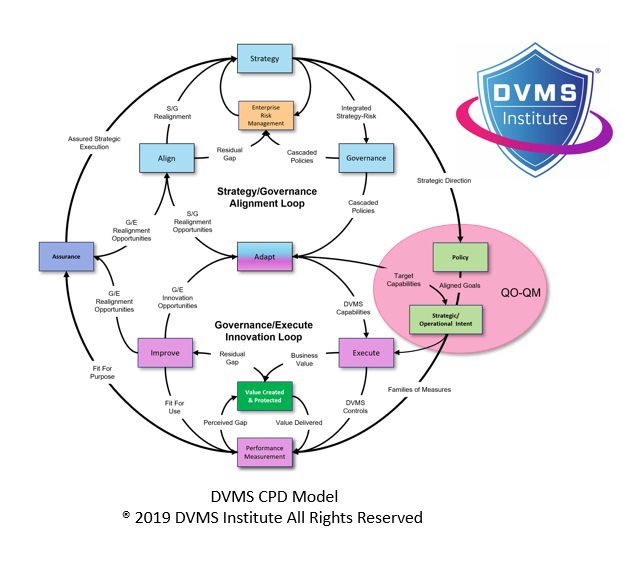Daily Leadership in Practice – Aligning Intent, Structure, and Behavior
David Nichols – Co-Founder and Executive Director of the DVMS Institute
Every leader I know faces the same frustration: we have plenty of models, frameworks, and theories. However, we struggle to get traction. The slide decks accumulate, the ideas are clear, but by Monday morning, we’re caught up in meetings, decisions, and conversations that don’t always align with the strategy we agreed on.
That gap between knowing and doing is where leadership either thrives or fails.
The 3D Knowledge Model—with its three axes of Leadership (Z-axis), Structure (Y-axis), and Behavior (X-axis)—is more than just another management model. It’s a way to clarify intent, aligning systems and lived culture. However, a model on a wall doesn’t change anything. The real challenge and opportunity are: how do you incorporate it into your daily leadership practice?
What follows is an explanation of how the 3D Knowledge Model can be applied. I’ll show how each axis unfolds at the executive, manager, and supervisor levels, with examples of leaders who have embodied these principles—sometimes intentionally, sometimes instinctively. For each, I’ll explain why it worked. Because without understanding the why, we’ll never close the gap between theory and practice.
Leadership (Z-axis): Executive Intent as Compass
At the executive level, leadership focuses more on clarity of purpose than on giving detailed instructions. The mistake many leaders make is over-specifying: instead of setting the direction, they try to control every detail. The result is rigidity, not resilience.
When Satya Nadella became CEO of Microsoft, he didn’t issue a lengthy 500-page playbook. Instead, he shifted the company’s focus to a simple guiding principle: “cloud-first, mobile-first.” He complemented this with a cultural shift toward a growth mindset. This wasn’t just a campaign slogan—it served as a clear guiding star. Managers and teams were encouraged to innovate, knowing exactly what “good” looked like.
Why did it succeed? Because intent isn’t about dictating actions, it’s about guiding judgment. Nadella fostered clarity without restriction, enabling the organization to adapt quickly and efficiently.
Another well-known example is Johnson & Johnson’s Credo. For decades, executives have relied on the Credo as a practical guide during moments of crisis and uncertainty. During the Tylenol crisis in the 1980s, they made the costly decision to withdraw products from shelves. They didn’t need a new policy because their intent was already established in the Credo: patients and customers come first.
What’s the daily lesson for practice? Executives should ask themselves each day: “Have I made intent clear enough that, if I disappeared tomorrow, the organization could still make decisions aligned with our purpose?”
Success doesn’t begin with strategy; it starts with clarity of intent. Strategy without intent is noise.
Structure (Y-axis): Management as Translation Layer
If executives specify intent, managers translate it into supportive structures. Structures encompass policies, processes, incentives, and systems—any element that influences how work is accomplished. The risk is overengineering. Structures should foster adaptability, not hinder it.
Consider the Toyota Production System. Executives prioritized quality above all—nothing was more important than getting it right. Middle managers implemented that value through structures like the “andon” cord. On the factory floor, this meant that any line worker had the authority to pull the cord and stop the entire production line as soon as they noticed a defect. Lights would indicate the location of the problem, and supervisors would quickly respond to assist.
This wasn’t just a clever device; it was a structural expression of executive intent. By giving frontline workers real power to act, Toyota embedded adaptability and continuous improvement into the daily rhythm of work. Quality wasn’t a slogan on the wall—it was a lived behavior reinforced by system design.
Toyota’s structure was powerful not because of its elegance but because of its simplicity: workers closest to the problem were empowered to act, as managers created systems that allowed action instead of waiting for approval.
A more contemporary case is ING Bank’s agile transformation. Executives set intent for speed and innovation. Managers translated that into new structures, including squads and tribes, as well as different performance metrics and new cadences. These weren’t superficial changes; they reshaped how work flowed and how people collaborated.
What’s the lesson for daily practice? Managers should ask: “Does the way I structure work make it easier for teams to adapt responsibly—or am I boxing them in?”
Every system you design is a signal: it tells people to flex and adapt, or it tells them to comply and conform.
Behavior (X-axis): Supervisors as Cultural Reinforcers
Supervisors stand at the forefront of leadership. They are the ones who turn intent and structure into everyday culture—what people actually do on a daily basis. Their impact is profound because behavior spreads quickly.
During the COVID-19 pandemic, many nurse supervisors faced a unique challenge. Protocols were changing every day. Supervisors who framed safety rules as “compliance requirements” often faced resistance and fatigue. However, those who rephrased them as “acts of protection—keeping colleagues and patients safe” saw higher acceptance and morale. The shift from rules to purpose changed behaviors from reluctant compliance to shared responsibility.
Consider the example of Starbucks store supervisors. Corporate goals might focus on customer experience and ethical sourcing, but it’s the supervisor who makes these priorities real. A supervisor coaching baristas to explain where coffee originates or to pause and connect with a frustrated customer is reinforcing daily actions that reflect the strategy. The organizational values become tangible through small interactions.
What’s the lesson for daily practice? Supervisors should ask: “Did I reinforce the behaviors today that embody our purpose—not in words, but in actions?”
Culture isn’t a poster on the wall; it’s the sum of reinforced behaviors. Supervisors carry that responsibility more than anyone else.
Alignment in Action: A Full-Stack Example
It’s tempting to view these axes separately, but the strength of the 3D Knowledge Model lies in their alignment. A misalignment anywhere disrupts the chain.
One of the best examples of alignment comes from the U.S. Navy submarine command under Captain David Marquet (Turn the Ship Around!).
- Executives had set a broader intent: build leaders, not followers.
- Marquet, as the commander (manager in this analogy), restructured decision rights by shifting authority closer to the people with information. Instead of centralizing decisions, he established a practice where officers would say, “I intend to…” before taking action..
- Supervisors and crew, in turn, reinforced this behavior daily. The language of “I intend to” became a cultural practice, not just a slogan.
The result? A nuclear submarine once considered one of the worst performers became one of the best—not because of a new strategy, but because of alignment across leadership, structure, and behavior.
I “grew up” on US nuclear submarines and was privileged to serve under three skippers who embodied Captain Marquet’s leadership style. Adaptability on submarines equates with survivability, and it is adaptable to civilian and government environments.
A Simple Daily Framework
The beauty of the 3D Knowledge Model is that it doesn’t require grand initiatives to apply. It can be tested daily. Here are three reflection questions leaders at any level can ask:
- Leadership (Executives): Did I clarify intent today?
- Structure (Managers): Did I enable adaptability through the systems I touched today?
- Behavior (Supervisors): Did I reinforce the behaviors that embody our purpose today?
If you can answer “yes” to each, you’ve done more than manage—you’ve led.
My Thoughts
We didn’t create the 3D Knowledge Model as a theoretical exercise, but as a practical lens for leadership at every level.
- Executives provide clarity of intent.
- Managers translate intent into enabling structures.
- Supervisors reinforce behaviors that make culture real.
When these levels are aligned, organizations succeed—even during uncertainty. When they are not, misalignment quickly results in confusion, bureaucracy, and disengagement.
My challenge to you is straightforward: test the model tomorrow. In one decision, one structure, and one interaction, deliberately view it through the lens of leadership, structure, and behavior. Observe what unfolds.
Because theory is only helpful when it influences practice—and leadership is, above all, a daily practice.
About the Author

Dave is the Executive Director of the DVMS Institute.
Dave spent his “formative years” on US Navy submarines. There, he learned complex systems, functioning in high-performance teams, and what it takes to be an exceptional leader. He took those skills into civilian life and built a successful career leading high-performance teams in software development and information service delivery.
A Digital Value Management System® (DVMS) is a unified governance and assurance system that drives resilient, compliant, and trusted digital business operations amid continuous digital disruption.
For the CEO, a DVMS provides a clear line of sight between digital operations, business performance, and strategic outcomes—turning governance and resilience into enablers of growth and innovation rather than cost centers.
For the Board, a DVMS provides ongoing assurance that the organization’s digital assets, operations, and ecosystem are governed, protected, and resilient—supported by evidence-based reporting that directly links operational integrity to enterprise value and stakeholder trust.
For the CIO, a DVMS provides a structured way to align technology investments and operations with measurable business outcomes.
For the CRO, a DVMS embeds risk and resilience directly into operational processes, turning risk management into a driver of performance and adaptability.
For the CISO, a DVMS delivers a continuous assurance mechanism that demonstrates cyber resilience and digital trust across the enterprise and its supply chain.
By adopting a DVMS, organizations are positioned to:
- Maintain Operational Stability Amidst Constant Digital Disruption
- Deliver Digital Value and Trust Across A Digital Ecosystem
- Satisfy Critical Regulatory and Certification Requirements
- Leverage Cyber Resilience as a Competitive Advantage

DVMS Explainer Videos
- Architecture Video: David Moskowitz explains the DVMS System
- Case Study Video: Dr. Joseph Baugh Shares His DVMS Story.
- Overlay Model – What is an Overlay Model
- MVC ZX Model – Powers the CPD
- CPD Model – Powers DVMS Operations
- 3D Knowledge Model – Powers the DVMS Culture
- FastTrack Model – Enables A Phased DVMS Adoption
Digital Value Management System® is a registered trademark of the DVMS Institute LLC.
® DVMS Institute 2025 All Rights Reserved




